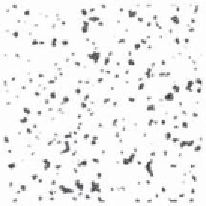Environmental Engineering Reference
In-Depth Information
(a)
(b)
Figure 6.6. Examples of model-generated patterns (trees or shrubs in black; grass or
bare soil in white). (a) “Pseudo-labyrinthine” pattern (in an 800
×
800 lattice, with
the same parameters as in Fig. 6.5,
D
=
0
.
3, uncorrelated random initial condition
with mean 0
350); (b) spot patterns [same
parameters as in Fig.
6.6
(a) but with mean initial condition
.
33, with simulation interrupted at time
t
=
=
0
.
28]. Figure taken
from
D'Odorico et al.
(
2007b
).
6.6 Random switching between two deterministic dynamics
6.6.1 Swift-Hohenberg process driven by dichotomous noise
A recurrent process of pattern formation in environmental fluid dynamics is associated
with Rayleigh-Benard convection (
Chandrasekhar
,
1981
). This phenomenon leads to
the emergence of organization in atmospheric convection, which is often evidenced
by well-defined cloud patterns (Fig.
6.7
). The organization results from (symmetry-
breaking) thermoconvective instability typically observed when a fluid overlies a hot
surface (
Chandrasekhar
,
1981
). To study the effect of hydrodynamic fluctuations in
systems exhibiting Rayleigh-Benard convective cells,
Swift and Hohenberg
(
1977
)
developed a stochastic model based on a biharmonic equation forced by additive white
noise. The deterministic counterpart of this model is frequently used to investigate
deterministic patterns emerging from symmetry-breaking instability of biharmonic
dynamics (
Cross and Hohenberg
,
1993
).
In Chapter 5 we introduced the Swift-Hohenberg model and discussed the ability
of additive and multiplicative Gaussian noise to generate patterns in Swift-Hohenberg
dynamics. Here we consider the case of a Swift-Hohenberg system driven by DMN
and the emergence of patterns induced by the random switching between two de-
terministic Swift-Hohenberg dynamics. The two dynamics have the same (Swift-
Hohenberg) spatial coupling term and two different local kinetics,
f
1
,
2
(
φ
):
∂φ
(
r
,
t
)
2
k
0
)
2
=
f
1
,
2
[
φ
(
r
,
t
)]
−
D
(
∇
+
φ
(
r
,
t
)
.
(6.11)
∂
t
Buceta and Lindenberg
(
2002a
) considered the case with
A
1
,
2
φ
1
3
2
f
1
,
2
(
φ
)
=−
±
φ
−
φ
∓
(6.12)



Search WWH ::

Custom Search